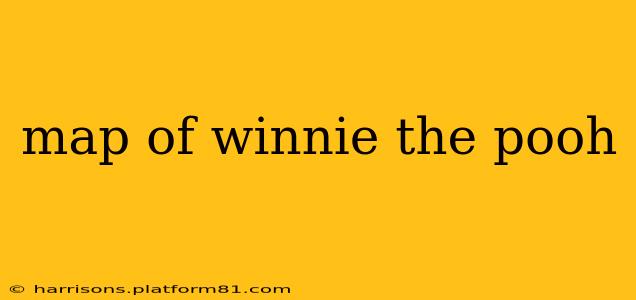The Hundred Acre Wood, home to Winnie-the-Pooh and his friends, isn't just a fictional landscape; it's a cherished childhood memory for millions. While no official, detailed map exists, we can piece together a fascinating topographical and social landscape based on A.A. Milne's stories and E.H. Shepard's illustrations. This exploration will delve into the locations we know and love, answering some frequently asked questions along the way.
What is the Hundred Acre Wood really like?
The Hundred Acre Wood is depicted as a whimsical, slightly chaotic, and idyllic place. It's a woodland environment characterized by rolling hills, meandering streams, honey-laden trees, and the occasional gloomy place, like the forest of 1000 scary things. It's a place of simple pleasures, close friendships, and everyday adventures. The size and exact location remain undefined, adding to its timeless appeal and allowing for endless imaginative possibilities. It's less a geographically precise place, and more a representation of childhood imagination and friendship.
Where is Pooh's house located in the Hundred Acre Wood?
Pooh's house is nestled near the edge of the wood, close to the stream and easily accessible to his friends. It's described as a cozy, somewhat disorganized dwelling, often cluttered with honey pots and other remnants of Pooh's culinary adventures. Its proximity to the stream suggests a convenient water source, and its location on the edge of the wood implies both accessibility and a degree of seclusion. Illustrations depict it as a simple dwelling, reflecting Pooh's humble and unpretentious nature.
Where is Rabbit's house located in the Hundred Acre Wood?
Rabbit's house is notably more organized and structured than Pooh's. It’s usually depicted as being deeper within the Hundred Acre Wood, sometimes positioned on a slight rise or hill, offering a commanding view of the surrounding area. Its location suggests a more established presence within the wood, reflecting Rabbit's responsible and somewhat bossy personality. The house features a meticulously kept garden and numerous burrows, emphasizing Rabbit's practical and orderly nature.
What other landmarks are in the Hundred Acre Wood?
Beyond Pooh and Rabbit's homes, the Hundred Acre Wood features several other key landmarks:
-
Owl's House: Situated on a tall tree, Owl's house often features in the stories, sometimes as a location for gatherings or as the source of wisdom (or occasionally, confusion). Its elevated position emphasizes Owl's self-perceived intellectual superiority.
-
The River: A significant feature winding its way through the wood, providing a source of water and a pathway for the characters' adventures. It's often the scene of boat rides and dramatic rescues.
-
Christopher Robin's House: Located near, but not strictly within the Hundred Acre Wood, Christopher Robin's house serves as the bridge between the fantastical world of the animals and the reality of the human world. It's often depicted as a large, comfortable family home.
-
The Honey Tree: The ultimate prize in the Hundred Acre Wood, this tree houses the coveted honey that fuels Pooh's adventures and appetites. Its location is variable throughout the stories, adding an element of mystery and excitement to the honey-seeking escapades.
-
Eeyore's Gloomy Place: The location of Eeyore's rather pessimistic dwelling, reflecting the somewhat melancholy personality of the donkey. It's usually portrayed as a somewhat sad and isolated spot, consistent with his disposition.
Is there a real Hundred Acre Wood?
No, there is no single real-world location that perfectly corresponds to the Hundred Acre Wood. A.A. Milne based his stories on the Ashdown Forest in East Sussex, England, which shares some similarities with the fictional wood. However, the Hundred Acre Wood is primarily a product of Milne's imagination, a place where childhood adventures come to life. The lack of a precise location adds to the wood's enduring appeal; it can exist wherever our imaginations take us.
This exploration provides a glimpse into the enchanting world of the Hundred Acre Wood, emphasizing that its charm lies not in precise geographical accuracy, but in its evocative imagery and timeless appeal. The map of the Hundred Acre Wood is ultimately a map of our own imaginations, brought to life by the magic of Winnie-the-Pooh and his friends.
